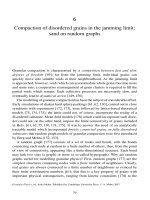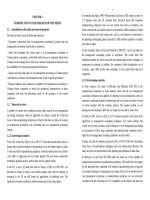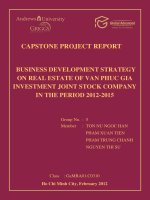Executive compensation in the say on pay era winning the shareholder value
Bạn đang xem bản rút gọn của tài liệu. Xem và tải ngay bản đầy đủ của tài liệu tại đây (277.02 KB, 31 trang )
Executive Compensation in the Say-on-Pay Era
Winning the Shareholder Vote — Without Losing the Election
Presenters: Doug Friske, James Kroll, Steven Seelig, Olivia Wakefield
April 7, 2011
© 2011 Towers Watson. All rights reserved.
Today’s experts
Doug Friske is the global leader of Towers Watson's Executive Compensation business and
is based in Chicago. He has more than 20 years’ experience advising a wide range of
organizations on all aspects of executive compensation.
James Kroll is a senior consultant in Towers Watson’s Executive Compensation practice,
based in New York. He specializes in corporate governance and executive compensation
issues and assists clients with shareholder approval of equity plans, advisory votes on
executive pay and other compensation-related governance issues.
Steve Seelig is the executive compensation counsel for Towers Watson’s Research and
Information Center in Washington, D.C. His expertise includes the taxation, accounting and
legal implications (including SEC disclosure requirements) of all forms of executive
compensation and perquisite programs.
Olivia Wakefield is a senior consultant in Towers Watson’s Executive Compensation
practice, based in Boston. Specializing in executive compensation programs, she advises
clients on topics such as annual and long-term incentive performance metric calibration and
plan design, equity pool management and corporate governance.
towerswatson.com
© 2011 Towers Watson. All rights reserved. Proprietary and Confidential.
2
Current context: Business performance has bounced
back to pre-recession levels
S&P 500 Composite
1,600
1,400
1,200
1,000
800
600
400
200
0
1/08
3/08
800
5/08
7/08
9/08
11/08
1/09
3/09
5/09
7/09
9/09
11/09
1/10
3/10
5/10
7/10
9/10
11/10
Net Income and Cash Flow
Cash Flow
Net Income
600
400
200
0
-200
-400
Q1Y08
Q2Y08
Q3Y08
Q4Y08
Q1Y09
Q2Y09
Q3Y09
Q4Y09
Q1Y10
Q2Y10
Q3Y10
Q4Y10
Source: Standard and Poor’s Compustat® database.
towerswatson.com
© 2011 Towers Watson. All rights reserved. Proprietary and Confidential.
3
So, what are we seeing as the say-on-pay era unfolds?
z
z
Evidence that contemporary pay practices have largely worked….
z
Overwhelming support for pay plans for most companies in the current
say-on-pay cycle (at least so far)
z
Pay levels that have returned to mid-2000 levels
z
Incentive designs that are essentially unchanged in recent years
z
Continued correlation between pay and performance
…although companies are continuing to refine their approaches
z
Push back on “poor” pay practices
z
More complete and thoughtful disclosure
z
Ongoing debate regarding the rigor in goal setting and the role of explicit
performance conditions for long-term incentives
It appears that most companies are getting it right, but with shareholders and
other constituents paying close attention, the situation can change quickly
and there’s no room for complacence
towerswatson.com
© 2011 Towers Watson. All rights reserved. Proprietary and Confidential.
4
Now we’ll take a look at where we’ve been — and where
we’re headed
Topic
Recent Trends in Pay Levels and Practices:
The Tale of the Proxies
Presenter
Olivia Wakefield
What We Know About Say-on-Pay Votes, So Far
James Kroll
What’s on the Regulatory Horizon?
Steve Seelig
Wrap-up and Q&A
Doug Friske
towerswatson.com
© 2011 Towers Watson. All rights reserved. Proprietary and Confidential.
5
Recent Trends in Pay Levels and Practices
The Tale of the Proxies
towerswatson.com
© 2010 Towers Watson. All rights reserved. Proprietary and Confidential. For Towers Watson and Towers Watson client use only.
S:\EGS\2010\ECR\175418\MKT\Proxy Webcast.ppt
6
The sample…
z
z
170 Fortune 1000 companies holding annual meetings on or after
January 21, 2011 (deadline for required say-on-pay votes under DoddFrank) that filed proxies by late March
Annual
Revenue*
Market
Capitalization*
25th Percentile
$3,000
$2,800
50th Percentile
$6,500
$7,900
75th Percentile
$13,500
$18,200
CEOs (principal executive officers) in the role for the past 36 months
*In millions of dollars.
Source: Standard and Poor’s Compustat® database.
towerswatson.com
© 2011 Towers Watson. All rights reserved. Proprietary and Confidential.
7
2010 pay levels clearly reflect companies’ improving
performance
Pay Element
Includes
2009 Median
Change
2010 Median
Change
Base salary
Annual salary
0%
3%
Total cash
compensation
(TCC)
Base + bonus (discretionary)
+ short-term non-equity
incentive compensation
3%
17%
Total direct
compensation
(TDC)
TCC + grant date value for
stock options, restricted stock
and performance plans
-1%
9%
Source: Towers Watson Executive Compensation Resources.
towerswatson.com
© 2011 Towers Watson. All rights reserved. Proprietary and Confidential.
8
The total pay mix really hasn’t changed that much
2008
2009
19%
22%
14%
41%
Cash
20%
21%
43%
Cash
19%
24%
42%
Cash
15%
22%
22%
57%
LTI
23%
15%
22%
23%
59%
LTI
2010
19%
58%
LTI
Base
Bonus
Stock Options
Restricted Stock
Performance Plans
Source: Towers Watson Executive Compensation Resources.
towerswatson.com
© 2011 Towers Watson. All rights reserved. Proprietary and Confidential.
9
What has changed is the long-term incentive mix
2008
37%
2009
39%
2010
38%
36%
26%
24%
33%
41%
26%
Stock Options
Restricted Stock
Performance Plans
Companies may be reacting to the recent volatility in the market
and are less comfortable using as many options
Source: Towers Watson Executive Compensation Resources.
towerswatson.com
© 2011 Towers Watson. All rights reserved. Proprietary and Confidential.
10
Prevalence of performance measures in long-term
incentive plans remained fairly constant…
Prevalence of Long-Term Incentive Performance Measures
0%
5%
10%
15%
20%
25%
30%
35%
40%
45%
50%
EPS/Net Income
TSR
Operating Income/Margin
ROC/ROIC
Revenue
2010
Other Non-Financial
2009
2008
ROE
Cash Flow
Source: Towers Watson Executive Compensation Resources.
towerswatson.com
© 2011 Towers Watson. All rights reserved. Proprietary and Confidential.
11
…as have annual plan measures for the most part…
Prevalence of Annual Incentive Plan Measures
0%
10%
20%
30%
40%
50%
60%
70%
EPS/Net Income
Individual Performance
Operating Income/Margin
Business Unit Performance
Revenue
Operating/Strategic
2010
Cash Flow
2009
2008
ROC/ROIC
ROE
Source: Towers Watson Executive Compensation Resources.
towerswatson.com
© 2011 Towers Watson. All rights reserved. Proprietary and Confidential.
12
…although a number of companies made adjustments in
2010
z
For annual plans
z
z
A quarter (25%) of companies changed the performance measures used for
2010 annual awards from those used in 2009
For LTI plans
z
Almost as many (24%) changed performance goals used for 2010 LTI
awards
Bottom line: Many companies continue to fine-tune
their programs to try to get it right
Source: Towers Watson Executive Compensation Resources.
towerswatson.com
© 2011 Towers Watson. All rights reserved. Proprietary and Confidential.
13
The distribution of CEO bonuses is back to pre-crisis
levels…
Percent of CEOs Receiving an Actual Bonus That is…
0%
5%
10%
15%
20%
25%
30%
35%
40%
>200% of target
>150% – 200% of target
>100% – 150% of target
>50% – 100% of target
2007
2008
2009
<50% of target
2010
0%
Source: Towers Watson Executive Compensation Resources.
towerswatson.com
© 2011 Towers Watson. All rights reserved. Proprietary and Confidential.
14
…and the alignment with performance continues to be
strong
Below Industry
Above Industry
Total Shareholder Returns
12%
Below Industry
Above Industry
Total Shareholder Returns
Above Market
Above Market
Below Market
76%
Total Direct Compensation
17%
2010
12%
Below Market
68%
Total Direct Compensation
Above Market
2009
15%
Below Market
Total Direct Compensation
2008
18%
66%
16%
Below Industry
Above Industry
Total Shareholder Returns
Source: Towers Watson Executive Compensation Resources.
towerswatson.com
© 2011 Towers Watson. All rights reserved. Proprietary and Confidential.
15
We also saw a close correlation between investor returns
and the value of LTI granted that the CEO realizes
Three-year TSR
(2008 to 2010)
LTI Realized/
LTI Granted*
Top-third TSR performance
33%
118%
Middle-third TSR performance
-1%
89%
Bottom-third TSR performance
-34%
49%
*Values include equity awarded to CEOs in fiscal years 2008, 2009 and 2010.
Source: Towers Watson Executive Compensation Resources; Standard and Poor’s Compustat® database.
towerswatson.com
© 2011 Towers Watson. All rights reserved. Proprietary and Confidential.
16
Companies made more one-time grants in 2010
z
Almost a third (29%) of companies made one-time and/or retention
grants in 2010, compared to 16% in 2009
z
In both years, the great majority of these grants were time-based
Companies Making One-Time and/or Retention Grants
2009
2010
16%
29%
71%
84%
One-time or retention
grants made
No grants made
Source: Towers Watson Executive Compensation Resources.
towerswatson.com
© 2011 Towers Watson. All rights reserved. Proprietary and Confidential.
17
Finally, our review found many changes in CD&As
z
They are longer
z
z
Executive summaries are now the rage
z
z
Average length increased by 7%
Half (50%) of companies added an executive summary during 2011, so that a
majority (64%) of companies now include one
Disclosures of annual plan goals improved
z
Fully 85% of companies disclosed the specific performance goals for the
2010 plan year
z
More than three-quarters (78%) of companies showed actual performance
attained for 2010 to support the bonus paid
Source: Towers Watson Executive Compensation Resources.
towerswatson.com
© 2011 Towers Watson. All rights reserved. Proprietary and Confidential.
18
What We Know About Say-on-Pay Votes, So Far
towerswatson.com
© 2010 Towers Watson. All rights reserved. Proprietary and Confidential. For Towers Watson and Towers Watson client use only.
S:\EGS\2010\ECR\175418\MKT\Proxy Webcast.ppt
19
Key observations to date
z
Overall, we’re seeing strong support for most companies’ proposals,
similar to last proxy season
z
Proxy advisors and some shareholders acknowledge that “outliers” will
come in for added scrutiny
z
The circumstances behind negative votes and company responses are
highly situational
z
No one approach will work for all companies
towerswatson.com
© 2011 Towers Watson. All rights reserved. Proprietary and Confidential.
20
Early say-on-pay votes show most companies are
receiving strong shareholder support…
Distribution of Support for Say-on-Pay Proposals: 2011*
Percentage of
Companies in
Support Range
80%
74.7%
60%
40%
20%
13.7%
2.7%
1.4%
2.0%
Below 50%
50% – 59.9%
60% – 69.9%
5.5%
0%
70% – 79.9%
80% – 89.9%
90%+
Support for Say-on-Pay Proposal
*Source: Towers Watson Executive Compensation Resources analysis as of April 4, 2011.
towerswatson.com
© 2011 Towers Watson. All rights reserved. Proprietary and Confidential.
21
…but a negative ISS vote recommendation has an impact
z
The 14% of companies receiving negative Institutional Shareholder
Services (ISS) vote recommendations have received above-average
opposition from shareholders
ISS Vote
Recommendation
z
Number of
Companies
Votes in
Favor
For
126
94%
Against
20
71%
Four companies have failed to get majority support for their say-on-pay
proposals
z
On average, only about 46% of shareholders at each of these companies
voted in favor of the say-on-pay proposal
z
ISS recommended votes against these proposals, citing such concerns as a
pay-for-performance “disconnect” or change-in-control provisions containing
tax gross-ups
Source: Towers Watson Executive Compensation Resources analysis as of April 4, 2011.
towerswatson.com
© 2011 Towers Watson. All rights reserved. Proprietary and Confidential.
22
Subpar TSR performance doesn’t necessarily result in a
negative ISS vote recommendation
z
Almost a third (29%) of companies failed both the one- and three-year
TSR test
z
Yet ISS recommended votes in favor of say-on-pay at more than two-thirds
(68%) of these companies
ISS Say-on-Pay Vote Recommendations for
Companies With Below-Median TSR
Negative
recommendations
(32%)
9%
18%
ISS support despite
pay-for-performance concern
ISS support, other factors (e.g.,
pay decrease, new CEO)
23%
ISS negative, pay-forperformance concern
ISS negative, other concern
50%
Positive
recommendations
(68%)
Source: Towers Watson Executive Compensation Resources analysis as of April 4, 2011.
towerswatson.com
© 2011 Towers Watson. All rights reserved. Proprietary and Confidential.
23
Say when on pay: After an early push for triennial, annual
votes gain steam
z
Three quarters (76%) of companies have seen annual vote frequency
receive majority support
z
Only one-third (33%) of companies recommending triennial votes
received majority support
Implementation of Say-on-Pay Vote Frequency
Original
Frequency
Recommendation
Companies
Recommending
Frequency
Frequency Implemented
Annual
Biennial
Triennial
Frequency
Decision
Pending
Annual
49
20
None
None
29
Biennial
9
3
1
None
5
Triennial
80
20
None
14
46
None
8
3
None
None
5
Total
146
46
1
14
85
Source: Towers Watson Executive Compensation Resources analysis as of April 4, 2011.
towerswatson.com
© 2011 Towers Watson. All rights reserved. Proprietary and Confidential.
24
After say-on-pay, now what?
Some next steps to consider
z
Define the vote outcome you want to see
z
Review proxy advisor reports for accuracy
z
Determine what additional information will help you gain greater
shareholder support
z
Assess the influence of proxy advisor vote recommendations
z
Determine who will represent the company in the shareholder
engagement process and the timing of outreach efforts
towerswatson.com
© 2011 Towers Watson. All rights reserved. Proprietary and Confidential.
25









